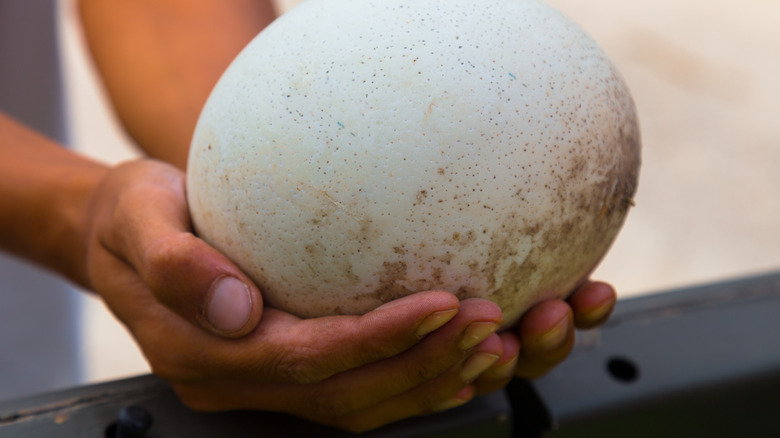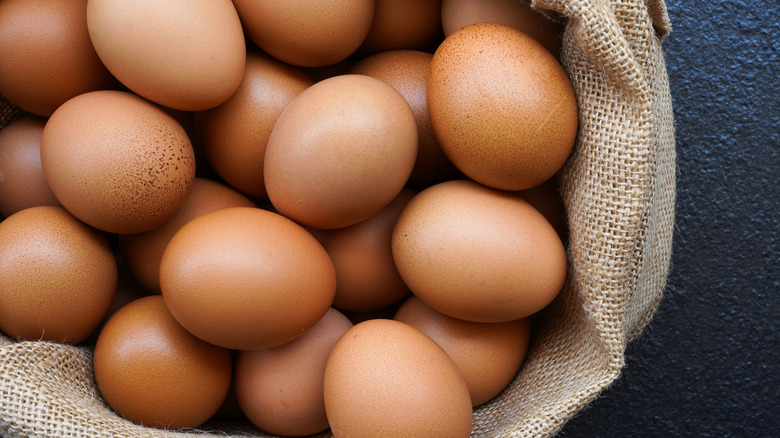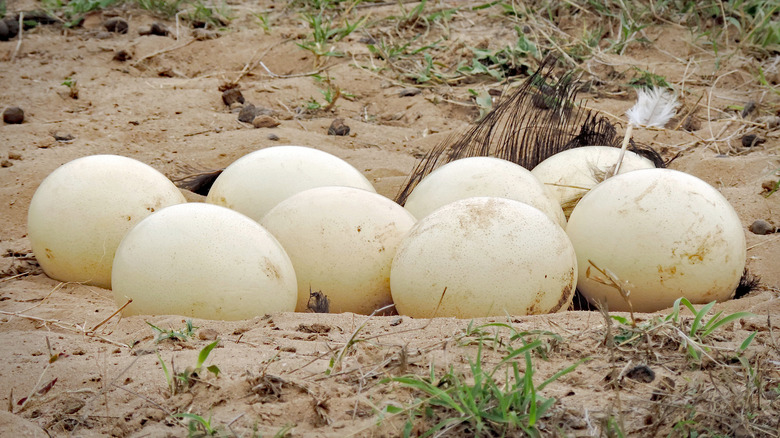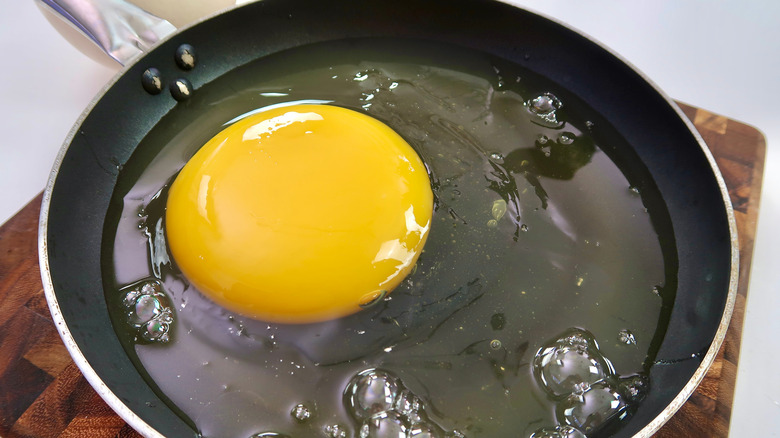How Ostrich Eggs Differ In Nutrition From Chicken Eggs
To say that eggs are an integral part of our lives would be a vast understatement. While it has fluctuated slightly over the years, on average Americans eat roughly 300 eggs per year (via The Washington Post). We enjoy eating eggs alone or as an ingredient in a countless number of dishes, ranging from breakfast to dessert. As a food item they are simply irreplaceable, but even beyond our diets, eggs are a significant part of our culture and language. We have all received early childhood lessons like "don't put all your eggs in one basket," or used expressions like "walking on eggshells". Even the author of our Declaration of Independence, Thomas Jefferson, coined the phrase "an egg today is better than a hen tomorrow."
With all we know about eggs of many types, most people only envision chicken eggs — which is fair, considering we typically only see those standard egg cartons at the grocery store. Some are familiar with duck eggs, but what about eggs from the largest bird on earth — the ostrich? These eggs can be intimidating due to their sheer size but should be considered by food explorers and those who want to change things up. Let's look at how they compare to our traditional chicken eggs.
Chicken or the egg?
Chicken eggs might very well be the most versatile food in the world, and are a very healthy source of protein and essential vitamins. According to Precision Nutrition, one chicken egg will typically contain about 6.5mg of protein. While they are low in carbs, they contain an abundant amount of healthy unsaturated fats and vitamins like B12 and iron (per Healthline). New dietary requirements actually call for about one-quarter of your meals to contain a protein source like eggs.
Whether or not to eat the egg yolk has been debated, with some suggesting that because it is high in cholesterol, it's better to just eat the egg whites. Precision Nutrition points out that, according to the most updated research, the cholesterol found in the yolk is not related to cholesterol problems we see associated with conditions like heart disease. Furthermore, by skipping the yolk you might be missing the healthiest part of the egg, as it is packed with protein and vitamin D, which does not show up in many other foods.
Remember — Don't be 'woke' when it comes to the yolk! Also, don't be concerned about the color as it is simply personal preference, and whether the egg is brown or white it does not make a difference in its flavor or nutrition (per Precision Nutrition).
Big and delicious
Ostriches are the largest bird on the planet; they can grow to nearly 6 feet tall and weigh over 300 pounds (per Bird Fact). While ridiculed in the bird world for not being able to fly, they can run away from those chasing them at nearly 45 miles per hour! This impressive bird lays eggs that are about 6 inches long and 5 lbs. in weight.
Fortunately for us, these eggs are not only big but edible: one ostrich egg — the equivalent of about two-dozen chicken eggs — has an impressive 2,000 calories and contains 100g of fat and 235g of protein, meaning you can surpass your daily needs with one single egg (according to Livestrong). They are similar to chicken eggs nutritionally, but with less vitamin E and richer in both magnesium and iron (via Safari). Furthermore, ostrich eggs have no sodium, which makes them a great replacement for chicken eggs for those with dietary restrictions.
According to Livestrong, ostrich eggs are often described as being slightly sweeter than chicken eggs, and more gamey and buttery. The size makes it a bit tricky to cook, and you may even need a hammer or screwdriver just to crack the shell. It takes around an hour just to boil this egg, and while it can be poached or fried (assuming you can find a pan that is large enough), it is easiest to scramble. Just make sure you are ready to eat scrambled eggs for a week!
When to use ostrich eggs
The average ostrich egg costs approximately 30 dollars and can be a challenge to find. Most likely you will have to reach out to an ostrich farm or find it at a farmer's market (via American Ostrich Farms). If you can manage its size in the kitchen, it can be used as an interesting alternative egg source. According to She Knows, you can make a delicious frittata or quiche with an ostrich egg — just make sure to use about 2 ounces of ostrich egg for every chicken egg needed in the recipe.
In addition to being an ingredient for omelets, Eat Delights recommends using ostrich eggs to make a homemade custard, lemon curd, or even to use as a base for a bearnaise sauce. Also, give it a go with an ostrich egg in any dish that calls for lots of eggs, like Angel Food Cake or any egg-rich bread. Instead of cracking dozens of chicken eggs, your recipe will only require a single ostrich egg.
Ostrich eggs have a history of being used for aesthetic purposes as well, and in ancient times the shells were used as symbols of fertility. In South Africa, it is believed that eating ostrich eggs will give you more energy and better vision, and it's common to eat rice out of the shells (per Eat Delights).
So get your tools ready to try out this unique alternative, and if all else fails, you could have an accessory for your home décor!



